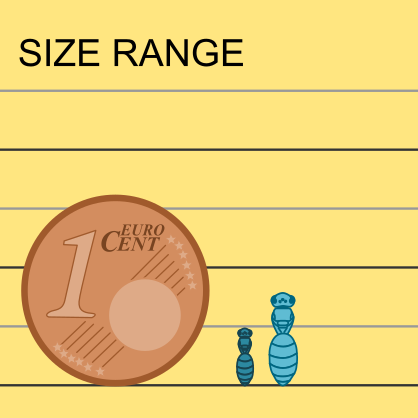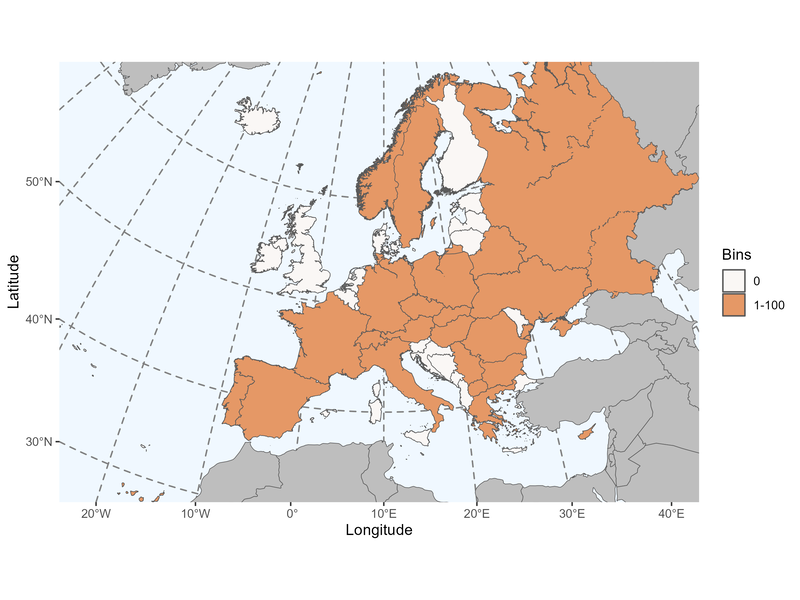Author: Nylander, 1848
|
Type species: Panurginus niger Nylander, 1848, monobasic.
Synonyms: Scrapter Lepeletier, 1841 (not Scrapter Lepeletier and Serville, 1828); Scrapteroides Gribodo, 1894; Greeleyella Cockerell, 1904; Birkmania Viereck, 1909. |
Clade: Anthophila
Family: Andrenidae Subfamily: Panurginae Tribe: Panurgini |
|
Distinctive traits
|
Pictures of distinctive traits
|
Morphologically close genera and how to distinguish them:
Clavipanurgus species have a vertex elevated on the sides (above the gena), so that the bee seem square-headed. They tend to be larger (vertex to sting around 9mm).
Camptopoeum, Flavipanurgus, Panurgus & Simpanurgus species submarginal cell 1 of similar size than cell 2, recurrent vein 1 distant from cubital transverse vein 1. Females have dense and long pilosity on posterior tibia and basitarsus.
Ammobates, Biastes, Parammobatodes & Pasites have a somewhat protruding clypeus and a long-tongue morphology (segments 1 and 2 of maxillary palpi are strongly elongated).
- Panurginus - Clavipanurgus
Clavipanurgus species have a vertex elevated on the sides (above the gena), so that the bee seem square-headed. They tend to be larger (vertex to sting around 9mm).
- Panurginus - Camptopoeum, Flavipanurgus, Panurgus & Simpanurgus
Camptopoeum, Flavipanurgus, Panurgus & Simpanurgus species submarginal cell 1 of similar size than cell 2, recurrent vein 1 distant from cubital transverse vein 1. Females have dense and long pilosity on posterior tibia and basitarsus.
- Panurginus - Ammobates, Biastes, Parammobatodes & Pasites
Ammobates, Biastes, Parammobatodes & Pasites have a somewhat protruding clypeus and a long-tongue morphology (segments 1 and 2 of maxillary palpi are strongly elongated).
General comments on Panurginus species identification
...
...
Sorry, but the species identification tool is not yet available for Panurginus.
Please check the reference(s) at the bottom of the page for traditional keys.
Please check the reference(s) at the bottom of the page for traditional keys.
List of the 15 Panurginus species found in Europe (Ghisbain et al. 2023):
Panurginus albopilosus (Lucas, 1849)
Panurginus alpinus (Warncke, 1972)
Panurginus alticolus Morawitz, 1875
Panurginus annulatus (Sichel, 1859)
Panurginus brullei (Lepeletier, 1841)
Panurginus corpanus (Warncke, 1972)
Panurginus herzi Morawitz, 1892
Panurginus labiatus (Eversmann, 1852)
Panurginus lactipennis Friese, 1897
Panurginus montanus Giraud, 1861
Panurginus romani Aurivillius, 1914
Panurginus schwarzi (Warncke, 1972)
Panurginus sericatus (Warncke, 1972)
Panurginus turcomanicus Popov, 1936
Panurginus tyrolensis Richards, 1932
Panurginus albopilosus (Lucas, 1849)
Panurginus alpinus (Warncke, 1972)
Panurginus alticolus Morawitz, 1875
Panurginus annulatus (Sichel, 1859)
Panurginus brullei (Lepeletier, 1841)
Panurginus corpanus (Warncke, 1972)
Panurginus herzi Morawitz, 1892
Panurginus labiatus (Eversmann, 1852)
Panurginus lactipennis Friese, 1897
Panurginus montanus Giraud, 1861
Panurginus romani Aurivillius, 1914
Panurginus schwarzi (Warncke, 1972)
Panurginus sericatus (Warncke, 1972)
Panurginus turcomanicus Popov, 1936
Panurginus tyrolensis Richards, 1932
References with identification keys for some of the species:
- Osytshnjuk, A.Z. (1978). Semejstvo Andreninae – Andrenidy. In Opredelitel nasekomych evropejskoj chasti SSSR. (pp. 315-369). Leningrad: Nauka.
- Schmid-Egger C. & Scheuchl E. (1997) Illustrierte Bestimmungstabellen der Wildbienen Deutschlands und Österreichs unter Berücksichtigung der Arten der Schweiz. Band Andrenidae. Velden/Deutschland.
- Patiny, S. (1999). Description de nouvelles espèces de Camptopoeum Spinola, 1843 (Hymenoptera, Andrenidae, Panurginae). Notes fauniques de Gembloux, 37, 71-76.
- Wood, T. J., & Cross, I. (2017). Camptopoeum (Camptopoeum) baldocki spec. nov., a new panurgine bee species from Portugal and a description of the male of Flavipanurgus fuzetus Patiny (Andrenidae: Panurginae). Zootaxa, 4254(2), 285-293.
Page contributors:
You noticed a mistake? You have a suggestion to improve this page?
Don't keep it to yourself, contact us and become a contributor to IDmyBee!
References used to write this page:
- Adrien Perrard (Dec. 2019)
- Adrien Perrard (Dec. 2023)
You noticed a mistake? You have a suggestion to improve this page?
Don't keep it to yourself, contact us and become a contributor to IDmyBee!
References used to write this page:
- Ghisbain, G., Rosa, P., Bogusch, P., Flaminio, S., Le Divelec, R., Dorchin, A., Kasparek, M., Kuhlmann, M., Litman, J., Mignot, M., Müller, A., Praz, C., Radchenko, V.G., Rasmont, P., Risch, S., Roberts, S.P.M., Smit, J., Wood, T.J., Michez, D. & Reverte, S. (2023). The new annotated checklist of the wild bees of Europe (Hymenoptera: Anthophila). Zootaxa, 5327(1), 1-147.
- Michener, C.D. 2007. The Bees of the World, 2nd Edition. The John Hopkins University Press, Baltimore.
- Michez D., Rasmont P., Terzo, M., Vereecken, N. 2019. Abeilles d'Europes. Hymenoptères d'Europes, Volume 1. N.A.P. Editions.
- Nieto, A., Roberts, S. P., Kemp, J., Rasmont, P., Kuhlmann, M., García Criado, M., ... & Michez, D. 2014. European red list of bees. Luxembourg: Publication Office of the European Union, 98. (IUCN 2014)
- Rasmont, P., Devalez, Jelle, Pauly, A., Michez, D. & Radchenko, V.G. 2017. Addition to the checklist of IUCN European wild bees (Hymenoptera: Apoidea). Annales de la Société entomologique de France 53: 17-32.


